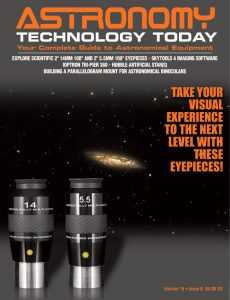
The University of Texas at Austin’s McDonald Observatory is celebrating its 80th anniversary this year. As part of the celebration a new exhibit highlighting the observatory’s history will opened this summer at its Frank N. Bash Visitors Center.
The McDonald Observatory is well known as being one of the most accessible professional astronomy complexes for amateur astronomers and the general public alike. The annual Texas Star Party includes activities at the observatory as one of its most popular attractions.
The observatory is an internationally known leader in astronomy education and outreach, a mission that began with the will of benefactor William Johnson McDonald, who stipulated an observatory for “the study and promotion of Astronomical Science.” It welcomes tens of thousands of visitors per year to public star parties and tours, hosts school visits, and carries out extensive teacher training programs. McDonald also produces StarDate, the longest running nationally syndicated science radio program heard daily on more than 300 stations.
The observatory’s long and storied history has led to a facility that is thriving scientifically while looking forward to a future bright with new discoveries and new technology.
“The McDonald Observatory is proud to serve as an engine of discovery for the faculty, researchers and students of The University of Texas at Austin and other Texas educational institutions, in addition to welcoming as many as 80,000 visitors per year to learn about astronomy, telescopes and the universe,” said Taft Armandroff, director of McDonald Observatory.
When it was dedicated on May 5, 1939, in front of many of the greatest astronomers of the time, McDonald Observatory consisted of a single dome housing not only the world’s second-largest telescope, but also living quarters and offices. In the decades since, each generation has added successive new-generation telescopes that astronomers have used to make important discoveries about our solar system, our Milky Way galaxy and distant galaxies.
The observatory’s first large telescope, a reflector with an 82-inch mirror, discovered new moons of Uranus and Neptune and identified carbon dioxide in the atmosphere of Mars and methane in the atmosphere of Titan, Saturn’s largest moon. A 107-inch telescope funded by NASA was dedicated in 1968. It bounced laser light off of the moon, studied the outer planets before NASA sent probes to them, made major discoveries about stars in the Milky Way, and found planets orbiting other stars. These telescopes, later named after Otto Struve and Harlan J. Smith (the directors who built them), are continually upgraded and still in constant use.
In the late 1990s, a UT-led consortium built the Hobby-Eberly Telescope (HET) at McDonald, which, with its 11-meter mirror, remains one of the world’s largest. Last year, HET completed a massive upgrade enabling it to begin the HET Dark Energy Experiment (HETDEX), a study of the mysterious force speeding up the expansion of the universe. The telescope also gained a new suite of instruments. VIRUS, the Visible Integral-field Replicable Unit Spectrograph, consists of 156 spectrographs that analyze light captured by HET and fed through 35,000 optical fibers, creating the world’s most powerful instrument of its type for surveying large areas of sky. Another new instrument, the Habitable Zone Planet Finder, uses precision technology to search for planets around red dwarf stars.
McDonald Observatory continues to add new telescopes and undertake new partnerships. It is a founding member of the Giant Magellan Telescope project, which is now building the world’s largest next-generation telescope in Chile. On site in West Texas, a partnership with the Las Cumbres Observatory Global Telescope Network has led to a 1-meter telescope currently in place and another to be delivered soon.
Additionally, a new partnership with UT’s Center for Space Research and NASA has led to the new McDonald Geodetic Observatory (MGO), currently under construction. It represents a continuation of five decades of “laser-ranging” research begun in 1969, when Apollo 11 astronauts left mirrors on the moon to be targeted with lasers from McDonald Observatory. The MGO, however, will focus on tracking changes in Earth’s shape, gravity and rotation.
A key factor in McDonald Observatory’s success is that it enjoys the darkest night skies of any professional observatory in the continental United States. To maintain this precious resource for the future, the observatory works tirelessly with nearby communities and businesses to keep unwanted light out of the sky, and is grateful to its partners in the Dark Skies Initiative.
UT’s Stephen Salisbury has recently published an in-depth look at the people and activities that make the McDonald Observatory so unique. You can read the full story here.
 And to make it easier for you to get the most extensive telescope and amateur astronomy related news, articles and reviews that are only available in the magazine pages of Astronomy Technology Today, we are offering a 1 year subscription for only $6! Or, for an even better deal, we are offering 2 years for only $9. Click here to get these deals which only will be available for a very limited time. You can also check out a free sample issue here.
And to make it easier for you to get the most extensive telescope and amateur astronomy related news, articles and reviews that are only available in the magazine pages of Astronomy Technology Today, we are offering a 1 year subscription for only $6! Or, for an even better deal, we are offering 2 years for only $9. Click here to get these deals which only will be available for a very limited time. You can also check out a free sample issue here.

